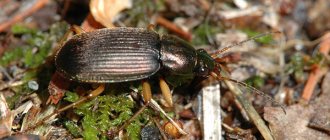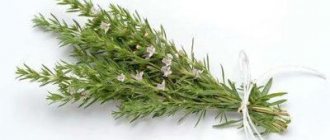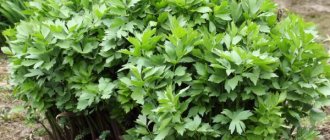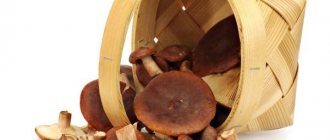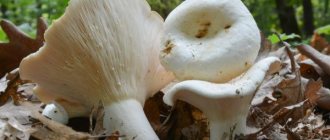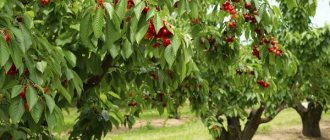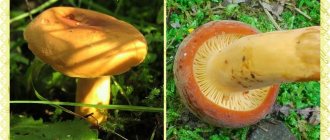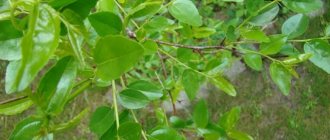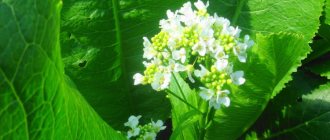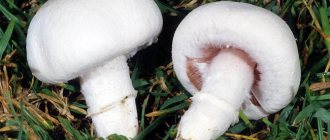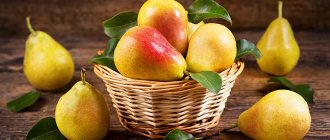- August 22, 2019
- Houseplants
- Natalia Egorenkova
“Muzhegon”, “mute reed”, “celibacy flower” - these are the names of Dieffenbachia, and it, as if nothing had happened, reigns in greenhouses, offices and our apartments. Some people adore this plant, while others are afraid to grow it because of its controversial reputation.
We will tell you what Dieffenbachia is, how it blooms and reproduces, and whether the plant needs special care. You will learn the signs associated with this flower, as well as the most common superstitions.
What kind of plant is Dieffenbachia?
This plant is native to the tropics of South and North America. A huge contribution to its study was made by Joseph Dieffenbach, an Austrian gardener, after whom the flower was named.
Dieffenbachia belongs to the aroid family, its closest relatives are anthurium (“male happiness”), spathiphyllum (“female happiness”), monstera and other tropical plants, no less popular in indoor floriculture.
The genus Dieffenbachia contains more than 60 species. Many of them have been actively used for decorating the interiors of public spaces and private homes for 150 years. Let's find out why the houseplant Dieffenbachia deserves its popularity.
Knowing the obvious disadvantages of Dieffenbachia, is it possible to keep it at home or is it better to throw it away?
You shouldn’t get hung up on popular beliefs, but it’s important to assess the possible harm caused by the plant due to its toxicity. If there are small children in the house, as well as animals, especially cats, it is better not to take risks. Or put the plant in a place where neither the baby nor the kitten can reach it. In general, to completely protect the most defenseless family members.
Description
People fell in love with Dieffenbachia for its beautiful leaves, forming a thick variegated cap that does not lose its decorative effect all year round. The leaf plates themselves are elongated-oval, dense and glossy. They can be on long or very short petioles. For decorative landscaping, species with unusual, patterned leaf colors and hybrids bred on their basis are used.
If the plant is not shaped, it will grow up to 2 m, while the trunk will become bare and the leaves will remain on the crown. Therefore, the growing point must be periodically trimmed, otherwise the flower will look like a broom.
Many who are just planning to get this plant are interested in how Dieffenbachia blooms at home. Just like in natural ones, but very reluctantly. Its inflorescence is a spadix, but unlike other aroids, it is extremely inconspicuous. Experienced flower growers advise removing it, because flowering takes a lot of energy from Dieffenbachia.
Now it won’t hurt to find out the most popular types of this flower for indoor use.
Diseases and pests
If the growing technology is violated, the flower is exposed to various diseases, as well as attack by harmful insects. As a preventive measure, the bush must be carefully examined to prevent the development of diseases and to eliminate the problem in a timely manner.
Pests that attack flower stems and leaves:
- Blackleg. To eliminate the pest, spraying with a 1% solution of Bordeaux mixture will be required.
- Aphids, which can be destroyed with a solution of tobacco dust. After 7 days, the procedure should be repeated.
- Spider mite. Its appearance is easy to notice - small cobwebs appear on the stems and internodes of the flower, and the leaves quickly fade. Eliminating a mite is not difficult - wipe the flower with soapy water, and then give it a warm shower.
The bush is also susceptible to fungal infections, which are divided into 3 types:
- viral;
- anthracosis;
- Fusarium
If fungus is detected, take the following measures:
- replace old soil with fresh one;
- water the bush with a weak solution of potassium permanganate;
- remove all damaged areas using sharp scissors;
- Sprinkle the resulting sections with activated carbon.
An important factor is proper care of the plant. Otherwise, the flower begins to hurt.
Why do the leaves turn yellow and what to do? – there are drafts in the room or the plant does not have enough heat.
Why do Dieffenbachia leaves dry out? This symptom is accompanied by several factors:
- insufficiently humid air;
- presence of drafts;
- the flower was watered with cold water;
- the room temperature is low.
Dieffenbachia has dropped its leaves. The reason for this behavior is rare or, on the contrary, abundant watering. Check the soil in the pot; if it is waterlogged and the leaves are drooping, check the roots for rot. To fix the problem, you will need to remove the damaged parts. The cuts must be treated with crushed coal, and the plant itself must be replanted in fresh soil.
Thus, if uncharacteristic signs appear, the conditions for keeping Dieffenbachia should be reconsidered.
Dieffenbachia bausei
This plant attracts with its unusual, marbled leaf pattern. The leaf plate itself, about 35 cm long, is painted a pleasant yellowish-green color.
Based on these and other species, many different varieties have been bred. They are tall and dwarf, with different shapes, textures, colors and leaf patterns.
Among them there are plants with glossy, matte and seemingly embossed leaves, very light and dark green. Thanks to the work of breeders, everyone can choose their own Dieffenbachia without any problems. Caring for any variety at home will not cause much trouble.
Types of Dieffenbachia with photos and names
There are more than 60 varieties of this plant. They make up two large groups: dieffenbachia bush and tree-like. The first type is plants with many lateral branches.
As they grow, they resemble bushes. The second type has a strong, thick, tall stem. The lateral branches of such Dieffenbachia gradually die off, the plant becomes like a tree with a crown.
The most loved by gardeners are the spotted, otherwise painted (Dieffenbachia Maculat), and variegated (Dieffenbachia picta, or painted). However, besides them, there are many more beautiful forms of Dieffenbachia.
Motley or painted
International Latin name: Dieffenbachia Picta. The leaves are oval, 40x15 cm. The pattern is light specks and strokes. Closer to the middle there is a cluster of dark green spots. The stem is woody, dense, height up to 2 meters.
Spotted or painted
Scientifically known as Dieffenbachia maculate. The leaves are elongated, ellipsoidal, with a sharp tip, their size is 50x12 cm. They are decorated with light spots of different sizes.
They are mainly located in the middle of the leaf, and along the edges there is a dark green color. The stem is woody, dense, grows up to 1 m.
Leopold's (Dieffenbachia Leipoldii Bull)
An extremely unusual shape: a trunk with a diameter of about 2 cm and a height of only 5 cm. The side shoots rise up to half a meter.
Dark green oblong ellipsoidal leaves of medium size: 35x15 cm. A pronounced light stripe runs along the central vein of the leaf plate.
Lovely or pleasant (Dieffenbachia Amoena)
The oval leaves are notable for their light stripes on a dark background. They diverge radially from the center, coloring each lateral vein. The fleshy, dense, woody stem reaches 1.5 m in height.
Attention! The species is tolerant of unfavorable conditions: excessive darkness, dry air, high temperatures, and red spider mite infestation.
Seguina
Ovate or lanceolate leaves with a pointed tip (50x16 cm) are mottled with light spots close to the center. The central vein is dark green, as is the leaf along the edges. A plant with a thick herbaceous stem reaches 50 cm in height.
Oersted (Dieffenbachia Oerstedii)
The leaves are elongated, heart-shaped, 30–35 cm in length. The pattern resembles Dieffenbachia Leopold, but there may be single light spots along the edges of the central light pronounced vein. The bush has a strong trunk up to 1.8 m.
Attention! Oersteda is sensitive to minimal air pollution and needs a lot of light. Temperatures below +14 °C are destructive for it.
Magnificent or royal
International Latin name – Dieffenbachia Magnifica (Rex)
The leaves are oval, with a rounded tip, up to 40 cm in length, light green with specks - white or yellowish. The stem is dense, up to 1 m.
It does not tolerate temperature changes, and it needs to be watered more often.
Vesuvius (Dieffenbachia Vesuvius)
The leaves are lanceolate, elongated, with a pointed tip. marbled color: light green plate with dark green, yellowish and white spots.
This is a bush form, the stems are herbaceous, strong, stable. Height 60–70 cm.
Camilla
Dieffenbachia Camilla has lanceolate leaves of medium size, 35–40 x 15 cm. The pattern is interesting: a light creamy center with a dark green edging.
Bush form, herbaceous, mobile stems. Grows up to 2 meters.
Dieffenbachia compacta
Light green leaves with a light center have dark green spots and the same edging. The shape is lanceolate with an elongated pointed tip.
Dieffenbachia Maculata Compacta grows to 55–65 cm and is a bushy form with herbaceous, mobile stems.
large-leaved
Wide, ovate, monochromatic leaves (up to 60 x 40 cm) give this variety its name: Dieffenbachia Macrophylla. The powerful woody stem grows up to 1 m.
Attention! The juice of this large-leaved Dieffenbachia has an unpleasant, pungent odor.
Bowmann (Dieffenbachia bowmannii)
It features incredible leaves: 70–80 cm in length. The plates are lanceolate, with an elongated pointed tip, dark green with light inclusions.
Bush form, strong stems, up to 1–1.5 m in height.
Bause (Dieffenbachia Bausei)
Oval, medium-sized, up to 40 cm, leaves with a slightly pointed tip. The pattern is in the form of cream-colored streaks with dark green spots. The powerful, stable stem rarely exceeds 1 meter in height.
It feels unwell in the shade and cannot tolerate temperatures below +10 °C.
Tropic Snow (Dieffenbachia Tropic Snow)
Light green foliage with light blurry spots. The shape is ovoid, the tip is slightly pointed, 50 x 30 cm. Stable stem up to 80 cm.
The best place for Dieffenbachia
Before you bring a tropical exotic plant into your home, consider where it will live. Dieffenbachia loves light, warmth and humidity, but from direct sunlight its luxurious leaves will quickly lose their decorative effect.
With a lack of lighting, the plant trunk becomes very elongated, becomes thin and fragile, and the leaves grow poorly.
Therefore, it is better to place the flower in bright rooms, on insulated loggias and verandas, but shade it from the sun. If favorable conditions are created for the plant, there is a chance to see Dieffenbachia bloom.
Like many tropical plants, its sap is poisonous. Therefore, Dieffenbachia is placed in places where small children and pets who like to chew greens cannot reach.
Dieffenbachia diseases
Like any ornamental plant, Dieffenbachia can get sick. Unfortunately, not all problems of Dieffenbachia can be dealt with:
- Rot. Affects the roots of the flower. Its development is provoked by excessive watering.
- Bacteriosis. The cause is bacteria. It appears as watery areas with clear boundaries. There is no treatment.
- Fungal diseases. With anthractic disease, the top of the plant is affected, dry spots form on the leaves, and Dieffenbachia begins to lose its foliage. Fusarium - damage to the roots and the entire plant. The roots turn black, and the leaves and stems begin to dry out.
- Viral diseases. Virus carriers are insects. Dieffenbachia leaves become covered with brown spots, curl and gradually dry out.
How to save a plant from diseases and pests:
Why do Dieffenbachia leaves turn yellow?
Possible reasons may be:
- insufficient watering or water with increased hardness;
- sudden changes in room temperature;
- long exposure to direct sunlight;
- cold;
- draft;
- lack of micronutrients in the soil;
- damage by root rot (especially with excessive watering).
Why do Dieffenbachia leaves dry out?
Here the question depends on which part of the plant the leaves have withered. If the upper, lateral and young ones, the cause may be irregularities in care.
When the lower and older leaves fall off and expose the trunk, there is no need to worry, this is the natural aging of Dieffenbachia. The plant is rejuvenated by cuttings.
Air temperature and humidity
Dieffenbachia feels great at temperatures of +17…+ 25 °C. Moreover, this regime can be observed in any season. This is an evergreen plant, so it does not require special maintenance conditions in winter.
But Dieffenbachia is extremely demanding when it comes to humidity. Of course, no one will create a tropical forest microclimate in the house. The lack of moisture is compensated by daily spraying the leaves with water at room temperature. This is considered an important condition for keeping Dieffenbachia and caring for any of its varieties at home.
If there is insufficient air humidity or infrequent watering of the leaves, their edges will begin to dry out.
How to care
Evergreen Dieffenbachia is an unpretentious plant, but some rules when growing it must still be followed.
Choosing soil and pot
For good growth, it is important to properly prepare the soil substrate. It is necessary to mix sand, peat and leaf soil in equal proportions. Add 4 parts of turf soil to this mixture. It is recommended to add charcoal to the finished substrate, which will protect the flower from diseases. For better moisture and breathability, you can mix brick chips or crushed bark in a small amount into the soil.
Suitable for growing exotics and universal soil for Dieffenbachia or fruit and leafy crops.
The perennial grows quickly, so you need to choose a pot for planting with a small margin. It must also be sustainable. Be sure to pour a thick layer of drainage (pebbles, river pebbles, expanded clay) onto the bottom of the pot.
Location and lighting
The best place for Dieffenbachia in an apartment is windows facing east or west, with diffused light. The brightness of the pattern on spotted leaves depends on proper lighting. Although Dieffenbachia is photophilous, it does not like direct sunlight. For specimens with uniform foliage color, more shaded areas are suitable.
In winter, with short daylight hours, so that the exotic crop does not lose its decorative effect, it is recommended to provide it with additional lighting (from 18 to 22 hours). Phytolamps or fluorescent lamps are suitable for these purposes.
The plant loves space. In summer it can be moved to the loggia or veranda. The main condition for this is the absence of drafts. Significant temperature changes between day and night are also undesirable for the flower.
Temperature, humidity, watering
In the room where the flower grows, the temperature all year round should not be below +17 degrees.
During active growth, Dieffenbachia needs abundant watering. In spring and summer, it needs to be watered every 2-3 days. In winter, the frequency of watering and the volume of water should be reduced - once every 5 days. The soil should not be over-moistened. The plant needs to be watered after the top soil substrate has dried to a depth of 1-2 cm in the summer, half the pot in the winter.
It is worth taking care of the air humidity in the room: it should be high. The leaves of the flower should be regularly sprayed with clean water at room temperature, especially in winter, since the air in the room is dried out by batteries. If there is insufficient air humidity, the edges of the leaves will dry out, which will adversely affect the decorative effect of the tropical exotic.
In hot weather, the plant can be periodically given a tropical shower outside or in the bathroom. The soil in the pot should be covered with polyethylene to prevent it from being flooded.
To increase air humidity, you can place a wide container filled with water next to the Dieffenbachia. A tray that needs to be filled with wet expanded clay and a flower pot placed on it is suitable as a humidifier. The moisture will evaporate from the pan, the leaves will be saturated with freshness, and the roots will not rot. A good option for moisturizing is using a household humidifier as needed.
Fertilizers and fertilizers
A young plant, when it is actively growing, must be fed regularly - once every 2 weeks. You can use complex fertilizer for variegated crops or nitrogen-containing organic matter. The first feeding is in April, the last one is in early October. There is no need to feed the flower in winter.
Transfer
A fast-growing plant at a young age requires annual replanting. An adult Dieffenbachia is replanted once every 3-4 years, when the root system has filled the entire container. This can be determined by external characteristics: the roots will “peek out” from the drainage holes. It is better to carry out the transplantation procedure when the flower is still in the dormant stage (late winter - early spring).
The perennial is replanted using the transshipment method, carefully removing it from the old container with a lump of earth. Blackened and dried roots are cut off, and the sections are treated with crushed coal. The plant is placed in a new larger container with drainage holes. The side voids are filled with fresh nutrient soil and a new top layer is poured. Watered. After transplantation, the first feeding of Dieffenbachia is carried out a month later.
If replanting is not planned this year, then it is necessary, as far as possible, to replace the top soil substrate with a new one.
Trimming
Young Dieffenbachia does not need to be pruned. An elongated adult plant that has lost its decorative appeal is trimmed. As the exotic grows, the trunk becomes bare: the lower leaves dry out and die.
Two ways to help restore the aesthetic appearance of a flower:
1. Cut the plant horizontally, leaving a bare trunk 10 cm high. There must be two or three buds on the stump that will sprout. Remove the released juice with a napkin. The juice is poisonous, so you need to wear rubber gloves when working. If liquid gets on the skin, it should be washed off immediately with running water, then oil or greasy cream should be applied to the skin.
Sprinkle the cut with crushed charcoal, or activated charcoal if you don’t have charcoal. In order for the buds to hatch faster, you need to create a microclimate. To do this, cover the stump with a plastic bag or glass jar. The “greenhouse” needs to be ventilated periodically. After the shoots appear, remove the cover.
2. Rooting the tip of Dieffenbachia. We'll talk about this method below.
Advice: before the planned pruning, do not water the plant for four days, then much less toxic juice will be released from the wound.
Winter care
There is no need to create special conditions for the plant in winter. A tropical perennial needs a stable temperature all year round (+18…+25 degrees). The main thing is to eliminate drafts.
Do not forget about air humidification procedures, wipe and spray the leaves. You can periodically turn the pot towards the light source so that the color of the foliage is saturated on all sides.
Watering
Like many indoor plants, Dieffenbachia needs to be watered as the soil dries out. In excessively dry soil, the leaves will wither and rot if water stagnates. You can simply measure soil moisture with your finger; the soil can be dry no more than 2 cm deep. Or buy a special device - a soil moisture meter. You also need to make sure that the water does not stand in the pan.
Transfer
When the roots fill the pot, the Dieffenbachia is replanted. The signal will be roots peeking out of the drainage hole at the bottom of the pot. It needs to be done once every 3-4 years. Once every 2 years, remove the top layer of soil and add a new substrate.
The pot is selected a few centimeters larger
It is filled in the same way as when planting a young plant. Dieffenbachia is replanted with an old clod of earth. The drainage must be new. New soil mixture is added to the sides.
The best time for transplantation is the cold season. In winter, the plant is dormant. It will more easily bear the stress of changing the potty.
After transplanting Dieffenbachia, there is no need to use fertilizing . Especially if purchased land was used. The first fertilizer should be given to the plant no earlier than a month later.
Feeding
Every potential plant owner needs to know what to feed Dieffenbachia. Its growth, development and decorativeness largely depend on this.
Experts recommend adhering to the following rules for feeding Dieffenbachia:
- From May to September, apply fertilizers 2 times a month:
- in cold weather, when leaf growth stops, 1 feeding every 2 months is sufficient.
As the experience of indoor floriculture enthusiasts shows, various complex fertilizers are suitable for feeding Dieffenbachia, for example:
- “Uniflor-rost” is a composition with a predominance of nitrogen for decorative foliage plants.
- “Saintpaulia Miracle Garden” - this vermicompost-based fertilizer for violets is well suited for Dieffenbachia and dracaenas.
- Pokon is a universal organic fertilizer for indoor plants.
- BIOLAN is a complex universal composition based on broiler manure and seaweed.
Fertilizing with a predominance of nitrogen is good to use in the spring and for young plants, but do not overuse, otherwise the white color may disappear on the leaves of variegated varieties. The rest of the time, feed with organic matter. Dieffenbachia lovers are advised to dilute the formulations at 1/2 the dose indicated on the package.
Admiring the gorgeous foliage year after year without a hint of flowering, many begin to wonder whether Dieffenbachia blooms at home? If you really want to force her to throw away the arrow with a nondescript cob, experts recommend trying to stimulate flowering with the help of fertilizers for flowering indoor crops.
Dieffenbachia – photo
Dieffenbachia with its spectacular large leaves is always good: young and old, big and small. And we are ready to prove this in practice with our photo selection!
Trimming
It happens that the owners did not take care of their Dieffenbachia, and it practically turned into a palm tree, losing its decorative value. In this case, radical pruning will be required: the entire upper part is cut off, leaving a stump up to 10 cm high. Young leaves will develop from it quite quickly.
To prevent this from happening in the future, the regrown apical cutting, 15-20 cm long, is cut off as it grows.
Many owners of these plants lament that they have created ideal conditions for them, but there are still no flowers. You can see how Dieffenbachia blooms in a photo or in a botanical garden, and do not take away the strength of your own plant.
Reproduction methods
Apical rosette
Cut off the top of the plant, treat the cut with “Kornevin” or “Zircon” (for better root formation). Place the rooting rosette in water or damp sand. Cover with film. It is better to take a dark, opaque jar. Change the water in the container every two or three days, moisten the sand. The roots will hatch quickly. The seedling can be transplanted into a pot when the roots reach a length of 4 cm.
Stem cutting
Divide the stem into several parts (average length 10-15 cm). Each cutting must have 3-4 internodes. Dry the cut pieces for two days, treating the cut areas with charcoal. Then place them in a damp rooting substrate, leaving the buds on the surface. Cover with film. The temperature should remain optimal: +25 degrees.
Young cuttings take root faster than old woody ones: sometimes it takes six months before the first leaf appears. When three leaves form, the shoot is transplanted into a separate pot along with the old stem. It cannot be removed, otherwise the root may rot.
Reproduction
If desired, trimmed parts of Dieffenbachia can be used for propagation. It is important to carry out all manipulations with rubber gloves to avoid burns.
The apical cutting is rooted in a mixture of peat and perlite, having previously been kept in the Kornevin solution. Or you can put it in water until roots form.
After radical pruning, a long bare trunk with nodes remains, which is divided into cuttings about 10 cm long. The cut areas are treated with activated carbon and the cuttings are planted in the ground, but not vertically, but horizontally. New Dieffenbachia will appear from viable nodes. They can decorate the whole house or give it to a person without prejudices.
The benefits and harms of Dieffenbachia
The juice of almost all types of Dieffenbachia is quite poisonous: if it gets into the mouth, it can cause a burn to the throat, and if it gets on the skin, it can cause dermatitis. Therefore, we recommend carrying out all work with the flower with rubber gloves. A dieffenbachia pot should not be placed in places accessible to children and pets. Due to the poisonous nature of the plant or for other reasons, some gardeners prefer not to grow this flower in their apartment.
Meanwhile, Dieffenbachia at home brings many benefits. Here are just some of its useful properties:
- Large succulent leaves are a reservoir for water. At elevated temperatures, moisture from the leaves begins to evaporate, moistening the surrounding area. The atmosphere in the room improves, the air becomes fresher, and you can breathe much easier.
- Dieffenbachia leaves release phytoncides (biologically active substances) into the surrounding air, which fight pathogenic bacteria and reduce their activity. This property is often used in medical institutions to decorate hospital wards.
- Several Dieffenbachia bushes indoors are also known to effectively cleanse the atmosphere of harmful chemical compounds such as benzene and formaldehyde. This is useful to know for people living in close proximity to industrial enterprises.
- Dieffenbachia has a positive effect on the condition of the human heart and blood vessels. The substances released by the flower have a positive effect on the female body, namely, they slow down the aging process, help fight excess weight and skin problems.
Signs
Pots with Dieffenbachia are often used to decorate workrooms and offices, as it has been noted that its presence has a beneficial effect on the work mood - it is easier for a person next to this flower to do routine work and concentrate his attention on specific issues.
The optimal place for Dieffenbachia in an apartment is a table against the wall, a tall cabinet in an office or library. You can also place a flower in a spacious kitchen - then its positive effect will extend mainly to the woman, and it will not affect the man. This flower has no place in bedrooms and children's rooms.
We did not describe to you the negative signs and superstitions associated with the beautiful Dieffenbachia. We do not believe in them and we recommend that you not focus on them, especially since these superstitions have never received scientific confirmation. Experts say that Dieffenbachia can be grown at home, you just need to know the basic rules for caring for it. After all, a sick or frail plant is unlikely to show itself properly.
The dark side of Dieffenbachia: signs and superstitions
Of all the names that people have given to Dieffenbachia, the right one is o or “dumb rod”. American planters actually used this plant for sophisticated punishment of slaves. The guilty slave was forced to swallow a piece of Dieffenbachia stem or leaf. The juice of the plant caused swelling of the larynx, and the person could not speak for several days.
Many people doubt whether it is possible to keep Dieffenbachia at home. Signs and superstitions are the reason for this:
- It is believed that the young mistress of Dieffenbachia will remain an old maid, and a married woman will certainly become a widow.
- This plant, by its very presence, dramatically worsens the physical and emotional state of men.
- A childless couple will not wait to replenish their family.
- With the advent of Dieffenbachia, financial problems will fall on household members.
- The cat will leave the house.
There is also a belief: if the owner finally sees Dieffenbachia blooming, this can be regarded as a warning about impending changes, not for the better.
Dieffenbachia pruning
Over time, the lower part of the plant becomes bare and loses its attractiveness, so for proper care it is necessary to trim the flower. To do this, you need to prepare the tools and all the necessary materials:
- medical alcohol;
- several tablets of activated carbon;
- hacksaw;
- cotton wool or cosmetic discs;
- latex gloves;
- half-liter glass jar.
Be careful! Dieffenbachia juice is quite poisonous, so it is important that it does not get on your skin or clothing. If even one drop gets on the mucous membrane or skin, it can provoke an allergic reaction or poisoning.
When pruning the plant, you need to protect the skin.
You should use gloves, an apron and a cloth to wipe up the juice.
To reduce it, you can not water the flower for several days before pruning.
The procedure can be performed at any time of the day or year. Full pruning is carried out every three years.
This video shows how to prune and what kind of bushy plant you get as a result:
Cuttings remaining after pruning are often used to propagate Dieffenbachia (you can read more about this here)
Should you believe omens?
Don't you think it's easiest to blame the cause of any problems on someone else, for example, on a plant? In many cases, people do just that, and, of course, there is no documented evidence of the adverse effects of Dieffenbachia.
Moreover, the forums are full of posts from happily married women raising children who have had this plant for decades.
Dieffenbachia lovers believe that this flower fills the house with positive energy, purifies and ozonates the air, and brings joy and aesthetic pleasure. It can also be used as a natural barometer: when droplets of moisture appear on the leaves, it means rain.
If you are still interested in how often Dieffenbachia blooms, then theoretically this could happen every year. But there is no beauty in this, and there is no benefit for the plant either. Therefore, if Dieffenbachia has bloomed, admire it once, and then cut out the arrows until the flowers form.
Why can't you keep it at home?
It is not because of the poisonous juice that they refuse to grow the flower indoors. Various mystical qualities are attributed to him.
In ancient times, people believed that the leaf of a flower could take away a person’s speech. This phenomenon is quite understandable: when poisonous juice gets into the mouth, swelling of the tongue and larynx occurs - because of this, the person cannot speak.
Nowadays, the plant is called “husband”, considering it a symbol of celibacy. The belief says that a man cannot be in a room with Dieffenbachia, as it negatively affects his masculine energy. It is not recommended for unmarried girls to grow it, and married girls are at risk of infertility.
The southern exotic also has a positive sign - it takes away negative energy. The flower should be grown not in the bedroom, but in other rooms, for example, in the kitchen, living room, study. Dieffenbachia will extinguish outbursts of anger if it is treated with love and care. There will be harmony in family life.
“Green barometer” is what the southern exotic is often called. Before rain or snowfall, droplets of “dew” appear on the leaves of Dieffenbachia. The plant reports an excess of moisture in the air, getting rid of its excess.
Home care
Despite conflicting opinions about growing it indoors, Dieffenbachia is a frequent guest in many apartments. Its original appearance stylishly complements the interior of any room, the main thing is to provide the right conditions.
Lighting
Dieffenbachia prefers bright and diffused light, but can also grow in moderate shade . With insufficient lighting, the plant becomes very elongated and distorted, the speckled leaves become small and lose their decorative patterns. Direct sun leaves burns on the leaves and they become discolored.
Temperature
It is necessary to maintain temperature indicators at + 18 – 23 degrees . If they are lower, the plant will often be affected by diseases and pests, and will also stop growing. strictly forbidden to overcool the roots .
Important! Dieffenbachia responds better to high temperatures than to low temperatures, but only with regular watering.
Transfer
To get a truly beautiful plant, the soil is loose and nutritious : turf and leaf soil with high-moor peat and coarse sand (2:2:1:1).
If you prefer store-bought soil, dilute it with baking powder and add nutrient soil. Be sure to use drainage. The holes in the bottom of the pot should always be clean so that excess moisture flows out freely.
Dieffenbachia loves spacious pots. Powerful roots will be constrained in a tight container. Young specimens are replanted every 2 to 3 years. Growing in floor pots - only when necessary. Instead, they refresh the top layer of soil.
This video explains how to properly care for a 2-meter plant - Dieffenbachia.
Watering
It is important to maintain a golden mean here. Regular and moderate watering is needed : without drying out, but also without swamping the pot. The soil should dry out at least 1/3 of the way. The water takes no cooler than + 25 degrees. On hot days with good lighting, watering can be increased .
When and how to fertilize?
In spring and summer - every 2 or 3 weeks (1.5 g of fertilizer / l of water). It is good to alternate mineral fertilizers with organic ones. For example, with rotted manure (part manure + part water). The mixture will infuse in 2 weeks. Then it is diluted in a ratio of 1:5. Fertilize one day after watering.
Note! Dieffenbachia is a paradoxical plant. Despite the poisonous juice, it also brings benefits. The flower improves the air, moisturizes it and fights bacteria, such as staphylococcus.
Is it safe to grow Dieffenbachia at home?
Dieffenbachia is a poisonous plant. A wild plant needs protection from pests, and the poisonous sap meets this need.
At home, it will not cause harm if you handle it correctly
The potty should be kept out of the reach of children and animals. So that they don’t accidentally try its leaves, which attract with their brightness.
Even a small piece of Dieffenbachia can cause a burn to the oral mucosa and respiratory tract. If it enters the stomach, there is a risk of internal bleeding.
It is better to avoid the plant when there is a cat at home. It is very difficult to remove anything from them. Since they can climb into any hard-to-reach place. Its juice, if it gets into the pet’s esophagus and stomach, can be fatal.
The plant is dangerous for allergy sufferers. In case of individual intolerance, it can cause heart failure
There is a popular belief about Dieffenbachia that it scares men away from home. People call it the “widow’s flower.” Allegedly, her owner, even if she starts a family, will not be able to give birth.
Another interesting fact about the plant. In Africa it was nicknamed “the silent rod.” In slave societies, its leaves were forced to be chewed by slaves as punishment. The milky juice affected the larynx and oral cavity. The man couldn't talk. This was the punishment for arguing with the owner.
Despite beliefs and poisonous properties, it is common in homes. It is grown and nurtured. The main thing is to take all precautions in this process.
